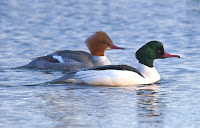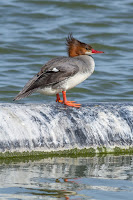COMMON MERGANSER
COMMON MERGANSER – (Mergus merganser) – (See images below)
DESCRIPTION: The Common Merganser is a fairly large diving duck. The drake is mostly white with a black head with green iridescence. The head has a crest but in the male it is usually not visible. The wings are white except the first upper half, which is black. The tail is grey, the bill red with a dark tip. The upper mandible ends with a small hook. Females are mostly grey with a red-brownish head and white under parts, and the crest is visible. The legs are red in both sexes. Juveniles are similar to the female but lack the head crest. This duck is around 70 cm (27 inches) long.
VOICE: https://www.xeno-canto.org/species/Mergus-merganser
NAME: The English name ‘merganser’ is a contraction of ‘mergus’ and ‘anser’, the latter meaning ‘goose’. The Latin genus name ‘mergus’ refers to a water bird. This duck is also called ‘goosander’ in Europe and Asia.
HABITAT: Prefers freshwater over saltwater habitats. The summer habitat of the common merganser encompasses rivers and lakes in the boreal forest. In addition for the winter they can be found in coastal areas.
DIET: This duck feeds on fish, aquatic insects and crustaceans. The bill has serrated edges to help hold fish.
NESTING: Common mergansers build their nests in tree holes in the forest, but also use other structures such as chimneys, nest boxes, even holes in the ground. The female can lay up to 17 eggs, which she incubates and cares for.
DISTRIBUTION: The breeding range of the common merganser covers the boreal forest of the Northern hemisphere. This duck is a partial migrant, and will move south of its summer range where it can find ice-free bodies of water in the winter. Some vagrants have been observed on Hawaii. (For information on bird vagrancy, please see the note below.)
DISTRIBUTION MAP: https://en.wikipedia.org/wiki/Common_merganser#/media/File:Mergus_merganser_distr.png
ON PEI: The common merganser breeds on Prince Edward Island, however this has ‘never been confirmed’ as per the Maritime Breeding Bird Atlas. Common around the island, and ‘very common’ in the fall and winter.
CONSERVATION: Although the population numbers of the common merganser has declined markedly in the last few decades, this duck does not yet appear on any list of threatened species. Possible factors for the decline may include pesticides and other pollutants in their environment, and hunting. This duck is also targeted by anglers because of its diet, which includes commercially valuable fish such as trout and salmon.
NOTES: Common mergansers are know to practice ‘creching’, where ducklings from many mothers are grouped together and cared for by an adult. So far it seems that the record of the ‘Mother of all mothers’ would be a Common Merganser with a creche of SEVENTY-SIX ducklings!! (Original photos here)
Vagrancy: In biology this means an animal going way outside its normal range. For birds, this can happen when there are storms and they get blown off course. On other times, the bird simply wanders in a different direction than usual. Here’s an article about vagrancy in birds.
SIMILAR SPECIES: Red-breasted Merganser, Hooded Merganser, Common Goldeneye (female), Barrow’s Goldeneye (female)
REFERENCES: https://www.borealbirds.org/bird/common-merganser
https://www.mba-aom.ca/jsp/toc.jsp ( Maritimes Breeding Bird Atlas)
https://www.audubon.org/field-guide/bird/common-merganser
https://www.allaboutbirds.org/guide/Common_Merganser/overview
http://www.birdweb.org/birdweb/bird/common_merganser
https://en.wikipedia.org/wiki/Common_merganser
http://www.ducks.org/hunting/waterfowl-id/common-merganser
DESCRIPTION: The Common Merganser is a fairly large diving duck. The drake is mostly white with a black head with green iridescence. The head has a crest but in the male it is usually not visible. The wings are white except the first upper half, which is black. The tail is grey, the bill red with a dark tip. The upper mandible ends with a small hook. Females are mostly grey with a red-brownish head and white under parts, and the crest is visible. The legs are red in both sexes. Juveniles are similar to the female but lack the head crest. This duck is around 70 cm (27 inches) long.
VOICE: https://www.xeno-canto.org/species/Mergus-merganser
NAME: The English name ‘merganser’ is a contraction of ‘mergus’ and ‘anser’, the latter meaning ‘goose’. The Latin genus name ‘mergus’ refers to a water bird. This duck is also called ‘goosander’ in Europe and Asia.
HABITAT: Prefers freshwater over saltwater habitats. The summer habitat of the common merganser encompasses rivers and lakes in the boreal forest. In addition for the winter they can be found in coastal areas.
DIET: This duck feeds on fish, aquatic insects and crustaceans. The bill has serrated edges to help hold fish.
NESTING: Common mergansers build their nests in tree holes in the forest, but also use other structures such as chimneys, nest boxes, even holes in the ground. The female can lay up to 17 eggs, which she incubates and cares for.
DISTRIBUTION: The breeding range of the common merganser covers the boreal forest of the Northern hemisphere. This duck is a partial migrant, and will move south of its summer range where it can find ice-free bodies of water in the winter. Some vagrants have been observed on Hawaii. (For information on bird vagrancy, please see the note below.)
DISTRIBUTION MAP: https://en.wikipedia.org/wiki/Common_merganser#/media/File:Mergus_merganser_distr.png
ON PEI: The common merganser breeds on Prince Edward Island, however this has ‘never been confirmed’ as per the Maritime Breeding Bird Atlas. Common around the island, and ‘very common’ in the fall and winter.
CONSERVATION: Although the population numbers of the common merganser has declined markedly in the last few decades, this duck does not yet appear on any list of threatened species. Possible factors for the decline may include pesticides and other pollutants in their environment, and hunting. This duck is also targeted by anglers because of its diet, which includes commercially valuable fish such as trout and salmon.
NOTES: Common mergansers are know to practice ‘creching’, where ducklings from many mothers are grouped together and cared for by an adult. So far it seems that the record of the ‘Mother of all mothers’ would be a Common Merganser with a creche of SEVENTY-SIX ducklings!! (Original photos here)
Vagrancy: In biology this means an animal going way outside its normal range. For birds, this can happen when there are storms and they get blown off course. On other times, the bird simply wanders in a different direction than usual. Here’s an article about vagrancy in birds.
SIMILAR SPECIES: Red-breasted Merganser, Hooded Merganser, Common Goldeneye (female), Barrow’s Goldeneye (female)
REFERENCES: https://www.borealbirds.org/bird/common-merganser
https://www.mba-aom.ca/jsp/toc.jsp ( Maritimes Breeding Bird Atlas)
https://www.audubon.org/field-guide/bird/common-merganser
https://www.allaboutbirds.org/guide/Common_Merganser/overview
http://www.birdweb.org/birdweb/bird/common_merganser
https://en.wikipedia.org/wiki/Common_merganser
http://www.ducks.org/hunting/waterfowl-id/common-merganser
 |
| Common merganser pair, Vaxholm, Sweden - by Bengt Nyman |
 |
| Common merganser female Las Gallinas Wildlife Ponds, CA - Frank Schulenburg |
 |
| Common merganser taking off Feb. 15, 2018, by Roberta Palmer |